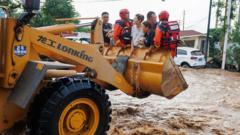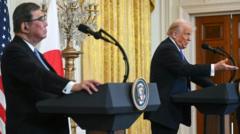The maneuver symbolizes a significant escalation in China's military capabilities and influence in the region, prompting heightened scrutiny from neighboring nations.
**China's Naval Ambitions: Two Carriers Challenge Pacific Dominance**

**China's Naval Ambitions: Two Carriers Challenge Pacific Dominance**
In a historic move, China's Navy sends dual aircraft carriers into the Pacific, testing military boundaries.
In a momentous development for military strategy in the Asia-Pacific region, the Chinese Navy has dispatched two aircraft carriers into the Pacific Ocean for joint exercises—marking the first occasion such a display of naval power has occurred beyond the confines of Chinese coastal waters, as stated by Japan’s Defense Minister, Gen Nakatani. Observations made by the Japanese government disclosed that the two active carriers, known as the Liaoning and Shandong, engaged in launching and landing fighter jets approximately 750 miles south of Tokyo near the Bonin Islands.
This unprecedented operation is indicative of China’s determined efforts to extend its maritime reach, signifying a step beyond the First Island Chain—an area that the Chinese government considers a vital barrier to foreign incursions. In bolstering its naval capabilities, China has not only optimized its current fleet with the two operating carriers but is also in the process of developing additional vessels, including the Fujian, which is currently conducting sea trials, and a fourth aircraft carrier that's still under construction.
The joint exercise is noteworthy not just for its operational scale, but also for the implications it holds for regional power dynamics. By venturing into waters adjacent to Japan, the Chinese fleet poses potential challenges to both the Japanese Self-Defense Forces and the U.S. Navy, particularly in scenarios where American naval assets from Hawaii and the West Coast would need to navigate near these strategic waters en route to Japan or Taiwan. Despite its expanding fleet, experts highlight that China's carriers remain smaller and less capable than the U.S. Navy's nuclear-powered supercarriers.
In response to China's maritime endeavors, Japan is countering with its military revitalization plans, which include the construction of its first new aircraft carriers since World War II, designed to host advanced U.S. F-35B stealth fighters. As these developments unfold, the stakes in the Pacific continue to escalate, ushering in a new era of geopolitical tension and military posturing.
This unprecedented operation is indicative of China’s determined efforts to extend its maritime reach, signifying a step beyond the First Island Chain—an area that the Chinese government considers a vital barrier to foreign incursions. In bolstering its naval capabilities, China has not only optimized its current fleet with the two operating carriers but is also in the process of developing additional vessels, including the Fujian, which is currently conducting sea trials, and a fourth aircraft carrier that's still under construction.
The joint exercise is noteworthy not just for its operational scale, but also for the implications it holds for regional power dynamics. By venturing into waters adjacent to Japan, the Chinese fleet poses potential challenges to both the Japanese Self-Defense Forces and the U.S. Navy, particularly in scenarios where American naval assets from Hawaii and the West Coast would need to navigate near these strategic waters en route to Japan or Taiwan. Despite its expanding fleet, experts highlight that China's carriers remain smaller and less capable than the U.S. Navy's nuclear-powered supercarriers.
In response to China's maritime endeavors, Japan is countering with its military revitalization plans, which include the construction of its first new aircraft carriers since World War II, designed to host advanced U.S. F-35B stealth fighters. As these developments unfold, the stakes in the Pacific continue to escalate, ushering in a new era of geopolitical tension and military posturing.



















